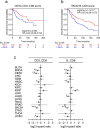Molecular and pharmacological modulators of the tumor immune contexture revealed by deconvolution of RNA-seq data
- PMID: 31126321
- PMCID: PMC6534875
- DOI: 10.1186/s13073-019-0638-6
Molecular and pharmacological modulators of the tumor immune contexture revealed by deconvolution of RNA-seq data
Erratum in
-
Correction to: Molecular and pharmacological modulators of the tumor immune contexture revealed by deconvolution of RNA-seq data.Genome Med. 2019 Jul 29;11(1):50. doi: 10.1186/s13073-019-0655-5. Genome Med. 2019. PMID: 31358023 Free PMC article.
Abstract
We introduce quanTIseq, a method to quantify the fractions of ten immune cell types from bulk RNA-sequencing data. quanTIseq was extensively validated in blood and tumor samples using simulated, flow cytometry, and immunohistochemistry data.quanTIseq analysis of 8000 tumor samples revealed that cytotoxic T cell infiltration is more strongly associated with the activation of the CXCR3/CXCL9 axis than with mutational load and that deconvolution-based cell scores have prognostic value in several solid cancers. Finally, we used quanTIseq to show how kinase inhibitors modulate the immune contexture and to reveal immune-cell types that underlie differential patients' responses to checkpoint blockers.Availability: quanTIseq is available at http://icbi.at/quantiseq .
Keywords: Cancer immunology; Deconvolution; Immune contexture; Immunotherapy; RNA-seq.
Conflict of interest statement
JB receives research support from Genentech/Roche, Bristol Myers Squibb, and Incyte Corporation; has received consulting/expert witness fees from Novartis; and is an inventor on provisional patents regarding immunotherapy targets and biomarkers in cancer. DJ is in the Advisory Board of Array, BMS, Genoptix, Incyte, Merck, and Novartis and has received research or travel support from BMS, Incyte, and Genentech. ZT is affiliated with ADSI and there are no competing interests related to this work. The remaining authors declare that they have no competing interests.
Figures





References
Publication types
MeSH terms
Grants and funding
LinkOut - more resources
Full Text Sources
Other Literature Sources
Molecular Biology Databases
Research Materials

